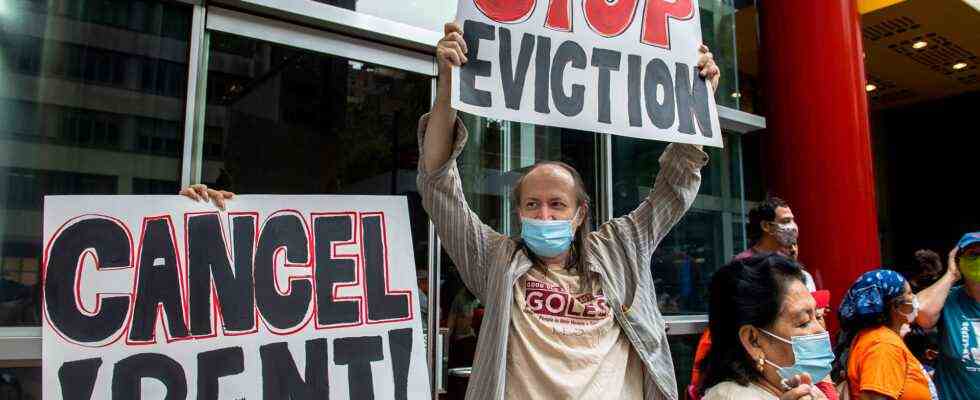Status: 08/12/2021 7:17 p.m.
First sick, then unemployed – and then without an apartment. The coronavirus triggers a fatal chain reaction for some Americans. This is all the more effective in cities like Baltimore, where there is not enough affordable housing.
Slowly, with shaky steps, Lashawn descends the stone stairs in front of the Baltimore District Court. Her teenage daughter supports her. The family comes out of a hearing. Her landlord wants to have her cleared out of her apartment, says Lashawn. She doesn’t want to give her last name there. She asked to postpone the eviction, which was scheduled for the following day, says Lashawn. But she only knew in the afternoon whether that worked.
There are anxious hours for the 44-year-old. Lashawn was a nurse in a Covid ward. Until she contracted the virus herself. At first without severe symptoms, but then came the nerve pain. The single parent could no longer walk and lost her job.
Then everything happened quickly. Default in rent. And suddenly: eviction. “I haven’t received anything from the state,” says Lashawn, “nobody gave me any money. I even found out yesterday that I can go to social institutions and get grants and help there.”
The money often does not arrive
And exactly here lies the problem. In theory, there is plenty of support for the estimated eleven million American tenants who are lagging behind with payments: the federal government has provided $ 47 billion. But in practice, the money often just doesn’t arrive, explains lawyer for housing law, Carisa Hatfield, who represents tenants like Lashawn in court.
Chaos, Hatfield says, is arguably the best word to describe what lawyers and renters have been through in the past few weeks and months. Completely overloaded authorities, constantly new rules and districts that interpret very differently who gets what money and when. What they are entitled to, what they can use and what not, whether they are put out on the street or are safe in the apartment for another day – that is unclear to many tenants. The eviction freeze, which the CDC has issued for the time being, also only applies in certain cases.
And so – despite the pandemic and overcrowded homeless shelters – people continue to take to the streets in many parts of the country. Lashawn is also afraid of it, because her family has no relatives with whom they could all stay. “I’ll be homeless,” she says, shaking her head in resignation.
It hits more blacks
What stands out: like Lashawn, black tenants in particular come out of the court. They are disproportionately affected by the evictions. So does Tanya, a young single parent in sneakers and a T-shirt. She also fell ill with corona and lost her job. She has received unemployment benefits and federal aid. But not enough to settle all the bills. And like Lashawn, she has no savings either.
“You have to decide,” she says, “which bill you will pay this week and which the next one. Which child will get clothes for school and which will not. That is not fair.” After the eviction, she will temporarily move into a hotel room with her three children. The city has rented them for such cases. At least until October. Above all, the uncertainty afterwards scares her.
The two faces of Baltimore: While the center is glittering, …
Image: AP
… neighborhoods like East Baltimore are very poor.
Image: picture alliance / AP Photo
Insufficient ownership – for generations
Both Tanya and Lashawn are from East Baltimore – a stark contrast to the chic, modern center of the city where the court is located. The further the bus travels to the east, the poorer the residential buildings become. Broken windows, holes in the roofs, miles of vacancy and in between a few sparsely inhabited houses under crumbling facades. Almost everyone who lives here is black. There are historical reasons for this, says attorney Hatfield: “Some of the people here may come from families who have not been able to accumulate property over generations to support them.”
Historically, it has long been much more difficult for them to buy property because of racism and discrimination. Today, statistically, 73 percent of white Americans are homeowners, but only 42 percent of blacks. So there are significantly more black tenants. And they are facing a full-blown housing crisis in cities like Baltimore. Because there is far too little affordable living space, too much of the income is often spent on rent. And if the job then breaks off due to Corona, it will be particularly tight for families like Tanya’s or Lashawn’s.
US President Joe Biden recently made an urgent appeal to states and municipalities to distribute the financial aid for tenants as quickly as possible. But whether that will happen before Lashawn and Tanya lose their apartment is uncertain.
Suddenly Debt – How US Tenants Fight During the Covid Crisis
Franziska Hoppen, ARD Washington, August 12, 2021 10:41 am

